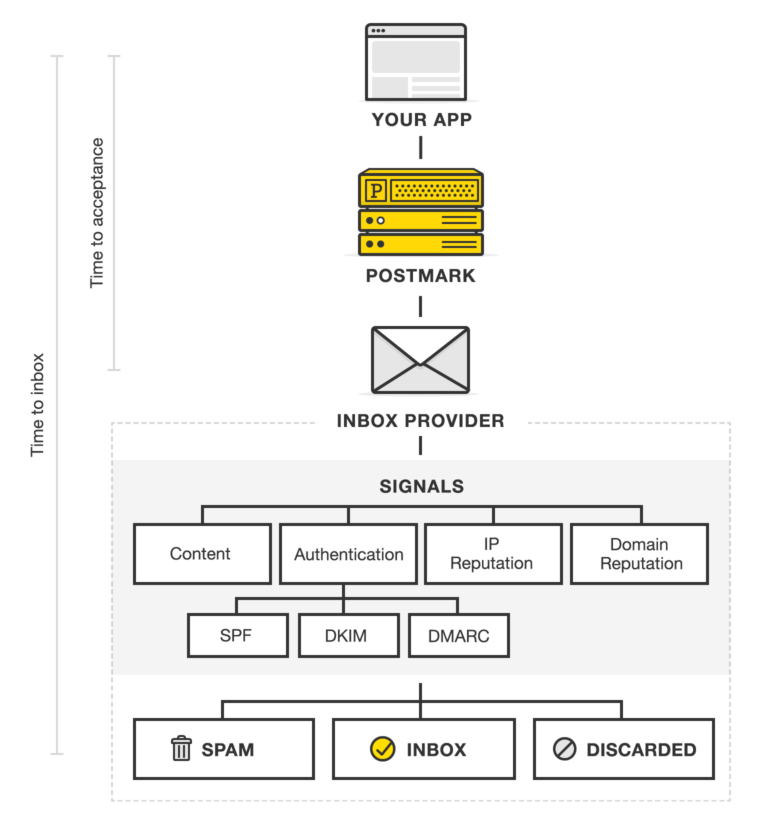What's the difference between "Accepted" and "Delivered" emails?
Folks often assume that when mailbox providers send a response of “Accepted,” that means that they successfully delivered the email to the inbox, but that’s not how it works. Acceptance is only the first step in delivery. Even if providers accept an email, there’s no guarantee how quickly they will deliver the email, whether it goes to the inbox or spam folder, or whether they deliver it at all.
So what happens after an email is accepted, and what does “Accepted” really mean? For the most part, it’s little more than the mail server saying “OK, I received it.” What they do after that is a black box. If they shared what they were doing, spammers could just work around it. So they keep it a secret. But there are plenty of insights that we can draw on.
Once providers accept an email, they run through a series of steps to determine how to handle it. Should we deliver this, put it in the spam folder, or silently discard it? They do this by using content filters, domain and IP reputation, authentication standards like SPF, DKIM, and DMARC, and even engagement levels for similar emails from that source. You can think of this like a bouncer checking ID at a nightclub.

How fast does the email get passed to the inbox? Even if an inbox provider decides to deliver an email, there’s no guarantee that they’ll do so quickly. Reputation and the type of email begin to have a significant impact at this step. If content filters, authentication, and engagement are the bouncer checking ID, reputation and type of email determine whether it’s on the VIP list. Transactional emails like password resets see much higher engagement than bulk promotional emails. Almost everyone both opens and clicks on their password reset emails, but only a fraction of people will open and click on every promotional email that comes through.
So inbox providers take reputation and engagement into account when deciding which emails are most important to recipients. This is one of the main reasons that inbox providers encourage you to send transactional and bulk emails from different IP addresses and domains. By doing so, it’s easier for your transactional emails to have a good reputation and get delivered faster.
We refer to these times as Time-to-acceptance and Time-to-inbox. Time-to-acceptance is the easiest to measure because it’s based on what the receiving mail server says, but Time-to-inbox is the one that matters to recipients because it’s a more accurate measure of their experience. Unfortunately, it's outside of a sender’s direct control. You can’t buy a better reputation. You build a reputation over time with consistent sending habits and high engagement.
Unfortunately, the only way to measure Time-to-inbox is to log into the recipient's email provider and check to see if the email was delivered to the inbox. In general, this is impossible because you can’t log into recipients’ inboxes to check. You can, however, login to accounts that you’ve set up. This is how we use MailHandler to monitor our Time-to-inbox for the major inbox providers and display it on our status page. It’s not an exact science, but it’s the closest reasonable proxy available.
Let’s look at some examples.
Say you just sent a bulk promotional email. Gmail is smart enough to recognize that 10,000 emails from the same IP address or domain in under a minute imply bulk email. Of course, over the years, Gmail has also built a database for reputation that lets it know that email from that IP address and domain has lower engagement and just isn’t as important to recipients. Gmail is also smart enough to know that bulk and lower engagement emails aren’t as crucial to recipients as transactional emails. So Gmail will queue up those bulk email with lower engagement and send them along to inboxes or spam folders at a leisurely pace.
Alternatively, say you send a password reset email. Since the recipient just requested it, chances are they’re hopping in their inbox and opening it as soon as it comes across. Since you’re sending it from your transactional email service, and you’re not sending thousands like it at the same time, Gmail can combine that with the reputation of the IP address and domain and previous engagement history to know that it’s an important email. It’s passed along immediately without any delays.
So don’t assume that just because your emails are being accepted that they’re also being delivered. They’re not the same, and there’s quite a bit of difference between the two.
Work hard to protect your sending reputation and monitor engagement with your emails. If you see one with low engagement, consider whether you need to send it at all. If people aren’t opening or clicking on it, then chances are they’re not finding value. Alternatively, if an email has low open and click rates, maybe it just needs some improvements. Perhaps a better subject or ‘From’ name could improve open rates. Maybe better copywriting or a more visible link will help improve clicks.
Just remember that it takes a lot more effort to build a good reputation than it does to destroy it. Closely monitor your sending and engagement, and you’ll be on the inbox providers’ VIP lists in no time.


